First USA ARDF Championships
Albuquerque, New Mexico, July 31 to August 4, 2001
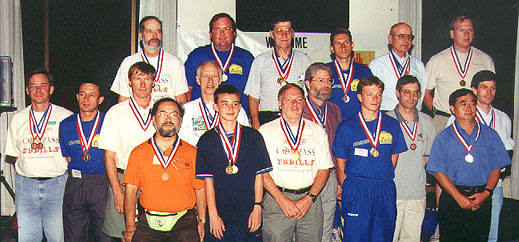

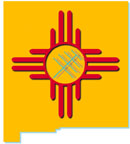 The 2001 USA ARDF Championships were a rousing success! Radio-orienteers from ten states plus Australia, China and Ukraine converged on Albuquerque, New Mexico to learn new ARDF techniques, practice their skills, and compete to see who is best in the country at this new (to us) Amateur Radio sport. Hosting USA's first festival of foxhunting was the Albuquerque Amateur Radio Club (AARC).
The 2001 USA ARDF Championships were a rousing success! Radio-orienteers from ten states plus Australia, China and Ukraine converged on Albuquerque, New Mexico to learn new ARDF techniques, practice their skills, and compete to see who is best in the country at this new (to us) Amateur Radio sport. Hosting USA's first festival of foxhunting was the Albuquerque Amateur Radio Club (AARC).
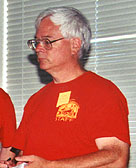 Early arrivers were treated to full-fledged practice sessions on both two and eighty meter bands, hosted by members of the Georgia Orienteering Club. This informal event on 30 July at Fenton Lake State Park, near Jemez Springs, also included a tri-tip beef barbecue supper courtesy of Marvin Johnston KE6HTS.
Early arrivers were treated to full-fledged practice sessions on both two and eighty meter bands, hosted by members of the Georgia Orienteering Club. This informal event on 30 July at Fenton Lake State Park, near Jemez Springs, also included a tri-tip beef barbecue supper courtesy of Marvin Johnston KE6HTS.
July and August is "monsoon season" in New Mexico. Warm moist air masses come in from the south, meet the mountains, and trigger thunderstorms almost every afternoon. Monday was no exception, and after a couple of brief showers during the 80-meter event, a real gully-washer broke out just as the barbecue ended.
Next day, the majority of the competitors arrived to stay in dorm rooms at the University of New Mexico (UNM) campus near downtown Albuquerque. They ate there too, at a facility that could hardly be called a "dorm cafeteria." It was actually a full-fledged food court with a variety of hot and cold selections for every meal, all you care to eat. Mike Pendley K5ATM (at right) was in charge of all the details regarding room and board at UNM.
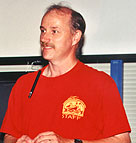 Wednesday, 1 August, was a full day of organization, instruction and practice, starting with the opening ceremonies, self-introductions, starting-order lottery, and a presentation from the US Forest Service about its "Leave No Trace" program. Next, AARC's Event Chair Jerry Boyd WB8WFK (at left) thoroughly explained the International Amateur Radio Union (IARU) ARDF rules. Sam Smith N4MAP of Georgia Orienteering Club then stepped up to cover all aspects of orienteering maps and forest navigation techniques. These presentations were primarily for newcomers to the sport, some of whom had never participated in a full-course ARDF event and had no idea what terms like "cairn," "spur," and "reentrant" mean.
Wednesday, 1 August, was a full day of organization, instruction and practice, starting with the opening ceremonies, self-introductions, starting-order lottery, and a presentation from the US Forest Service about its "Leave No Trace" program. Next, AARC's Event Chair Jerry Boyd WB8WFK (at left) thoroughly explained the International Amateur Radio Union (IARU) ARDF rules. Sam Smith N4MAP of Georgia Orienteering Club then stepped up to cover all aspects of orienteering maps and forest navigation techniques. These presentations were primarily for newcomers to the sport, some of whom had never participated in a full-course ARDF event and had no idea what terms like "cairn," "spur," and "reentrant" mean.
Everyone received a T-shirt with the event's "UFO" logo (blue for competitors, red for staff, see photo below). They were also given hydration backpacks and whistles for their health and safety in the forest.
The rest of Wednesday afternoon was for training and equipment checkout, with plenty of 80m and 2m transmitters on the air throughout the UNM campus. Would the reflections and other bearing aberrations caused by campus buildings be more severe than those in the forest to come?

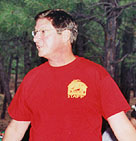 The big bus boarded at 0800 Thursday to take competitors 35 miles southeast of the city to Manzano Mountain State Park for the two-meter competition. It parked near the ending point, then AARC members drove them, a few at a time, down a narrow dirt road to the starting point (where the bus could not have gone). Scott Stevenson KC5VVB (at right) and his crew of volunteers were ready to send them off, two from different catetories at a time, into the woods at five-minute intervals corresponding with the start of Fox #1 (MOE) transmissions.
The big bus boarded at 0800 Thursday to take competitors 35 miles southeast of the city to Manzano Mountain State Park for the two-meter competition. It parked near the ending point, then AARC members drove them, a few at a time, down a narrow dirt road to the starting point (where the bus could not have gone). Scott Stevenson KC5VVB (at right) and his crew of volunteers were ready to send them off, two from different catetories at a time, into the woods at five-minute intervals corresponding with the start of Fox #1 (MOE) transmissions.
 Competor cards (at left) were already marked with bib number, category, and non-required foxes. They were printed on Tyvek to make them impervious to sweat and rain.
Competor cards (at left) were already marked with bib number, category, and non-required foxes. They were printed on Tyvek to make them impervious to sweat and rain.
Upon receiving their excellent maps (prepared by WB8WFK), the hunters discovered that the starting point was at the north end of the hunt area and the ending point was to the east. They would have to optimize their routes to find their required foxes along the way.
At the finish line, Mike Eaton K5MJE (AARC President, below right) and another volunteer crew awaited the hunters as they ran through the finish corridor. Boy Scouts at the entrance of the corridor used Family Radio Service (FRS) radios to alert finish line staff when runners approached. The last finisher came in just as the afternoon's thunderstorm began soaking the finish shelter area. A special-event HF station (K5T) was ready, but no one wanted to operate with lightning nearby.
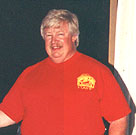 The bus route was exactly the same on Friday for the 80-meter hunt, because the hunt ended in the same place. The start, however, was 2.3 kilometers southwest of the two-meter start and the hunt area was south of the two-meter zone.
The bus route was exactly the same on Friday for the 80-meter hunt, because the hunt ended in the same place. The start, however, was 2.3 kilometers southwest of the two-meter start and the hunt area was south of the two-meter zone.
Everything went even more smoothly, almost every competitor did better, and the hunt was wrapped up before the rain came, except for one Chinese competitor who got lost. He was found just as the New Mexico Search and Rescue group was being assembled, resulting in some of the AARC hams being a bit late to the closing banquet that evening.
To no one's surprise, the two world-class Ukrainian competitors, Volodymyr Griedov and Serhiy Zarubin, turned in the best overall performances on both bands, finding all five foxes in less than 55 minutes each day. Serhiy did it in less than 37 minutes on the 80-meter hunt! Bruce Paterson VK3TJN and Adam Scammell VK3YDF from Australia also did very well in the M21 category (males of any age, five foxes required). Bruce took the bronze on two meters with a time under 61 minutes and Adam placed fourth on 80m by completing the course in less than 58 minutes. Gyuri Nagi HA3PA/KF6YKN was right behind Bruce on two meters and next day took the M21 bronze on 80m by crossing the finish in under 50 minutes.
Five USA and three Chinese runners squared off in the M40 category (males ages 40-49, four foxes required). Dale Hunt WB6BYU took gold on both bands with times under 83 minutes. Charles Scharlau NZØI, in his first formal ARDF event, grabbed silver on 2m and bronze on 80m with under-2-hour times. Scott Moore KF6IKO earned silver on 80m and Kevin Haywood N4MGB got bronze on 2m.
It was also USA-versus-China in the M50 category (males aged 50-59, four foxes required). Hou Huimin of China went from last place in the 2m hunt to gold medal winner on 80m. The other top positions in this division were a hard-fought contest between Dick Arnett WB4SUV, Bob Frey WA6EZV and Larry Benko WØQE. Dick took gold on 2m and silver on 80m. Larry was silver medalist on 2m. Bob got bronze on both bands.
The youngest (Jay Thompson W6JAY, who had just turned 16) and oldest competitor (Harley Leach KI7XF) were in categories by themselves. Each had excellent performances (Harley was under an hour on each band for his required 3 foxes) and each took home gold medals.
Results above are from the overall standings. Medals were also presented to the top three USA performers in each category. Winners of these were the same stateside hams listed above plus Gyuri Nagi HA3PA/KF6YKN (2m and 80m M21 gold), Sam Smith N4MAP (2m M21 silver), Hiroshi "Yoh" Izuta JF1RPZ/KG6CEH (2m M21 bronze), Dave D'Epagnier KØQE (80m M21 silver), Rick Barrett KE6DKF (80m M21 bronze) and Larry Benko WØQE (80m M50 bronze).
Among participants from areas of the USA that have regular ARDF practice sessions, there was lots of interest (and rivalry) to see which of these places would provide the most winners. So here's the medal count for these localities:
LOCALITY PARTICIPANTS TOTAL MEDALS GOLDS
Cincinnati, OH 2 8 3
Los Angeles, CA 7 7 4
Denver, CO 3 4 0
Atlanta, GA 4 3 0
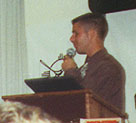 The closing banquet, organized and presided over by Brian Mileshosky N5ZGT (at left), included an excellent Mexican food buffet, the traditional token gift exchange, speeches of thanks, raffle prizes, lots of photos, and -- of course -- the medals. Then it was time to go pack the suitcases for departure by train, plane and highway the next morning.
The closing banquet, organized and presided over by Brian Mileshosky N5ZGT (at left), included an excellent Mexican food buffet, the traditional token gift exchange, speeches of thanks, raffle prizes, lots of photos, and -- of course -- the medals. Then it was time to go pack the suitcases for departure by train, plane and highway the next morning.
A hearty "Well done!" and thank-you to AARC and the event leaders, named and pictured above. Thanks to ARRL President Jim Haynie W5JBP, New Mexico Section Manager Joe Knight W5PDY, and Southwestern Division Vice-Director Art Goddard W6XD for attending and supporting. Thanks to the organizational and corporate sponsors who donated everything from busses to raffle prizes. And thanks to all the competitors, families and trainers for their interest, enthusiasm, and positive attitude.
A two-part Homing In series on the Championships by KØOV, with lots of photos, is in the December 2001 and January 2002 issues of 73 Magazine. An article by WB8WFK and N5ZGT is in the March 2002 issue of QST Magazine.
Joe Moell KØOV
USA ARDF Coordinator
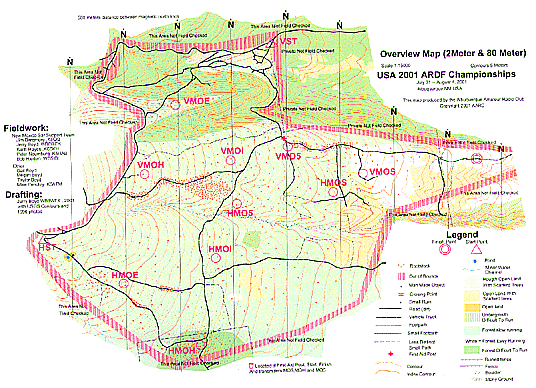
 Go to Championships Foxhunting News -- Recent and upcoming ARDF championships events
Go to Championships Foxhunting News -- Recent and upcoming ARDF championships events
Go to International-Style Foxhunting Comes To The Americas -- How we're getting the ball rolling
Go to Equipment Ideas for Radio-Orienteering -- Simple and inexpensive receiving RDF solutions
Go to Radio-Orienteering News for Southern California -- Results and stories of recent events in southern California, plus announcements of upcoming ones.
Go to Foxhunting for Scouts -- Let's get the kids involved
Go to Extenders Aid Handicapped Foxhunters -- A novel way to include persons with disabilities
 Back to the Homing In home page
Back to the Homing In home page
This page updated 19 December 2021